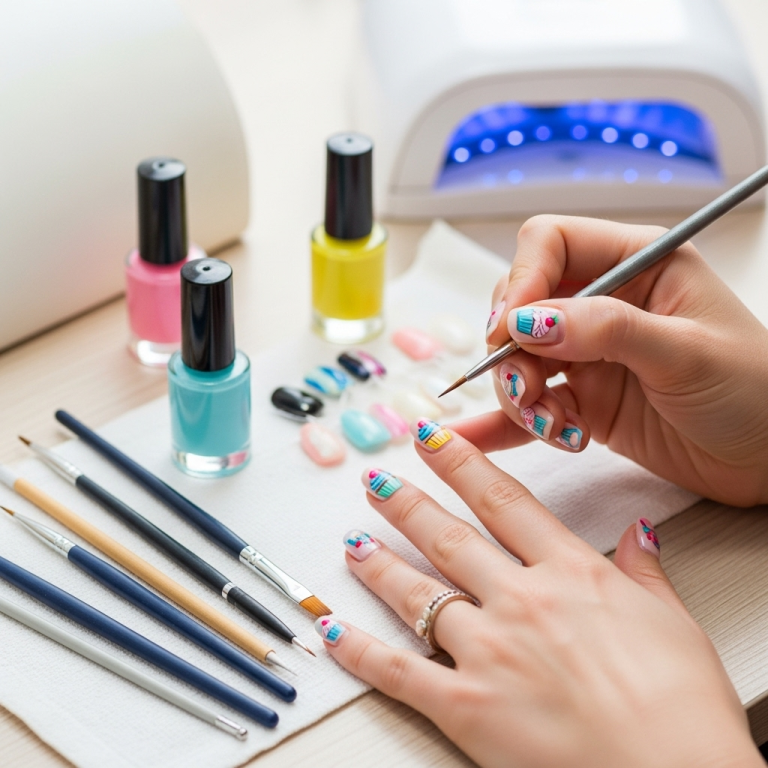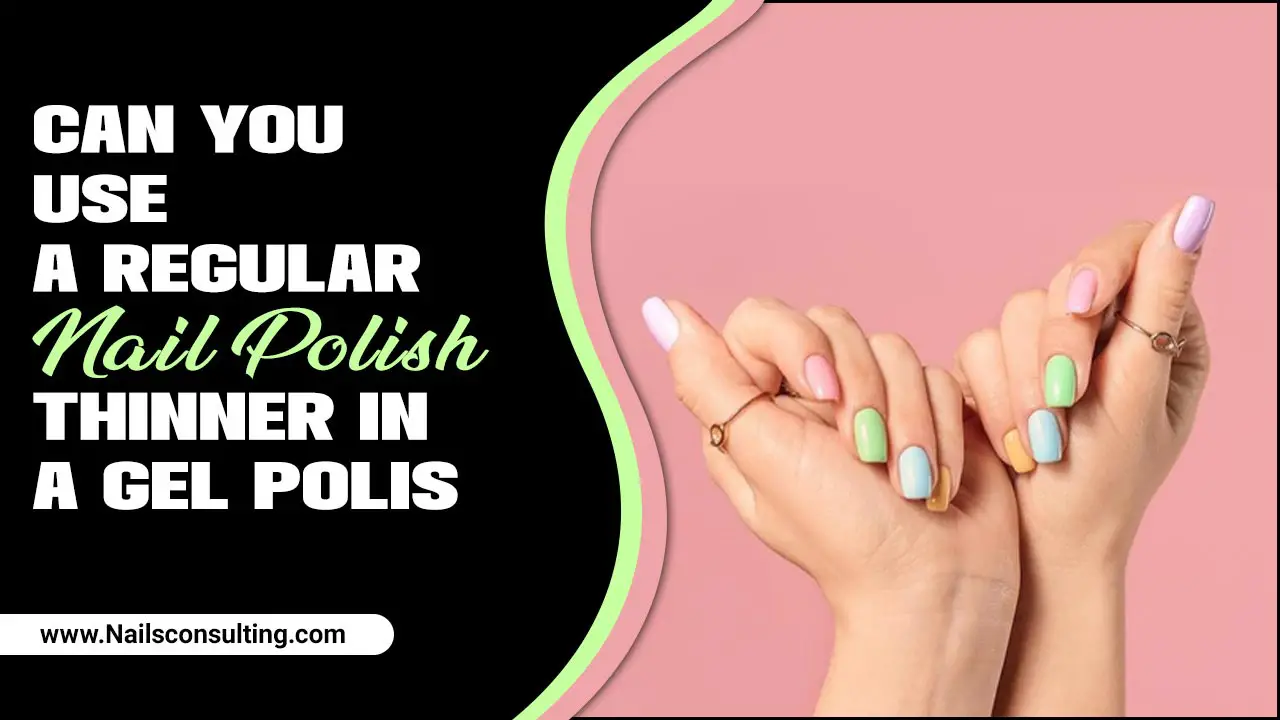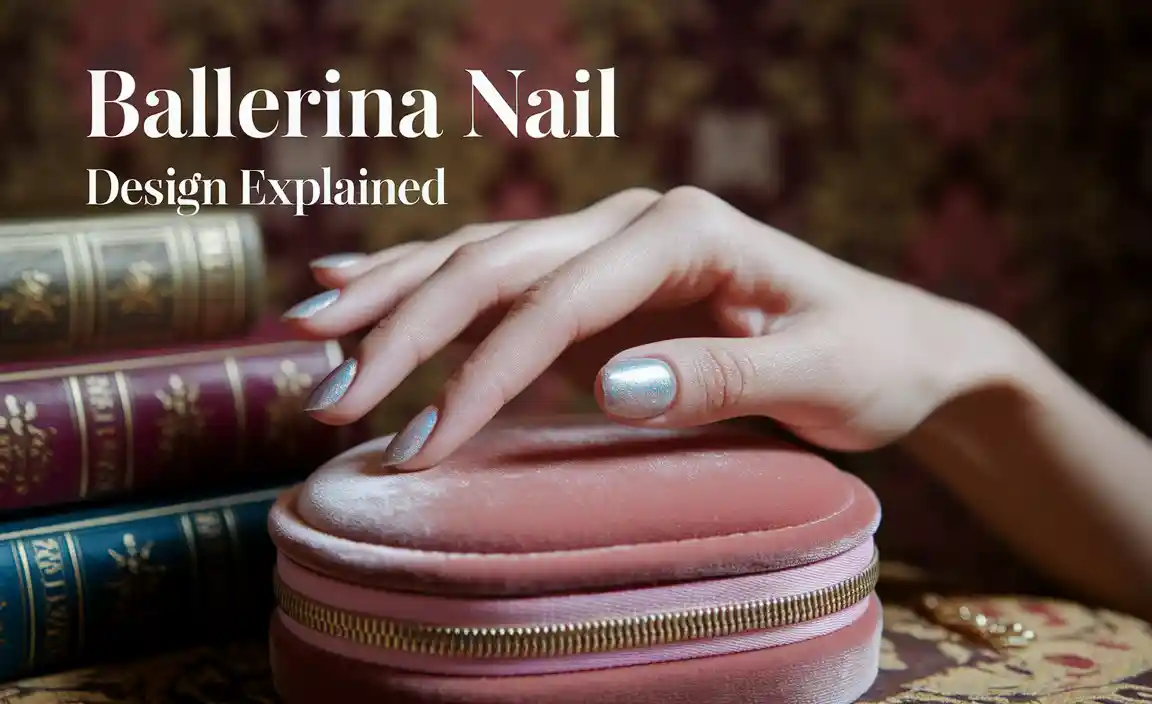Mastering Nail Designs With Tape for Beginners: Effortless Style in Minutes! Learn to create stunning, clean-lined manicures easily using everyday tape. This guide breaks down the process into simple steps, making salon-worthy nails achievable at home by anyone!
Dreaming of those super clean, geometric nail designs but worried it’s too complicated? You’re not alone! Many of us see those sharp lines and perfect angles on social media and think, “There’s no way I can do that!” But what if I told you that you probably already have the secret weapon in your desk drawer? Yep, we’re talking about tape! That’s right, good old-fashioned tape can transform your DIY manicures from basic to brilliant. It’s perfect for beginners because it acts as a guide, helping you create crisp, professional-looking designs without needing a steady hand. Let’s unlock your inner nail artist and discover just how easy stunning nail art can be!
Frequently Asked Questions
What Kind of Tape is Best for Nail Art?
For the best results with nail designs, painter’s tape (masking tape) or specialized nail tape are your top choices. Painter’s tape is readily available and has just the right amount of stickiness – it holds well without being too difficult to remove or damaging your polish. Be sure to choose the low-tack variety. Nail tape is even thinner and more flexible, offering incredible precision, but painter’s tape is a fantastic starting point for beginners.
How Do I Prevent Polish from Bleeding Under the Tape?
The key is to ensure your base coat and first color are completely dry before applying the tape. A good tip is to apply a quick-dry topcoat over your dry polish color. Once that topcoat is dry to the touch but perhaps not fully cured (a few minutes), apply your tape. This creates a slightly smoother surface and seals the edges of your polish, minimizing bleed-through. Also, press down firmly on the tape edges to create a good seal.
Can I Use Regular Scotch Tape?
While you can use regular Scotch tape in a pinch, it’s generally not ideal. It’s much stickier, which can lift wet polish when removed, and it’s less flexible, making it harder to conform to nail curves. It might also leave a sticky residue. Painter’s tape or nail tape offers better control and cleaner removal.
How Long Should I Leave the Tape On?
You want to remove the tape before the polish you’ve just applied has a chance to fully dry and harden. As soon as you finish painting the section over the tape, gently peel it off. If you wait too long, the polish might dry with the tape, leading to jagged edges or even lifting some of the underlying color. It should be removed while the new polish is still slightly tacky.
What Are Some Easy Nail Designs Using Tape?
Stripes are the most classic and easiest! You can create vertical, horizontal, or diagonal lines. French tips with super sharp lines are also simple with tape. Geometric shapes like triangles or squares, color-blocking, and even ombre effects using tape as a divider are all beginner-friendly and look incredibly chic.
What is the Best Way to Remove Nail Tape?
Peel the tape off slowly and steadily at a slight angle. Try to pull it back in the opposite direction of your cuticle or the edge of your nail. Avoid yanking or ripping it off quickly, as this can also cause jagged lines or lift the polish. If you notice a tiny bit of bleed, don’t panic – you can often clean it up with a small brush dipped in nail polish remover.
Unleash Your Inner Nail Artist with Tape
Welcome to the wonderful world of tape manicures! I’m Lisa Drew, and I’m thrilled to guide you through creating gorgeous nail designs using something you likely have at home right now. Forget intricate freehand painting; tape is the ultimate beginner’s best friend for achieving sharp, clean lines and professional-looking styles. It’s forgiving, versatile, and incredibly effective. Whether you’re aiming for minimalist chic or bold geometric statements, this guide will show you how to get there step-by-step. Get ready to elevate your nail game effortlessly!
Why Tape Is Your New Best Friend for Nail Designs
If you’ve ever admired sharp, geometric nail art or perfectly crisp French tips and thought it was beyond your skill level, think again! Tape is a game-changer for DIY manicures, especially for beginners. It acts as a stencil, a shield, and a guide, all rolled into one. This simple household item helps you create clean, defined lines that are notoriously difficult to achieve freehand. It’s your secret weapon for making trendy, salon-quality designs accessible and achievable right at your kitchen table.
- Precision Without Practice: Tape provides a straight edge or a defined shape, eliminating the need for a super steady hand.
- Versatility: It can be used to create stripes, color blocks, geometric patterns, and even sharp French tips.
- Accessibility: You likely already have painter’s tape or masking tape, which works wonderfully, making it a budget-friendly option.
- Time-Saving: For many designs, tape can actually speed up the process compared to painstaking freehand work.
- Mistake Correction: When used as a guide, tape can help you paint within lines, reducing the chances of messy mistakes.
Essential Tools for Your Tape Manicure Adventure
Before we dive into the fun designs, let’s gather your supplies. You don’t need a fancy professional kit to start! Most of these items are common household or drugstore finds. Having everything ready beforehand makes the whole process smoother and more enjoyable.
| Tool | Description & Why It’s Important |
|---|---|
| Nail Polish Colors | Your base color(s) and accent color(s). Choose at least two contrasting colors for a striking look. |
| Base Coat | Protects your natural nails from staining and helps polish adhere better. Essential for a long-lasting manicure. |
| Top Coat | Seals your design, adds shine, and prevents chips. A quick-dry formula is a lifesaver! |
| Painter’s Tape (Low-Tack) | The star of the show! Low-tack painter’s tape (the blue or green kind often used for walls) is ideal. It adheres well but removes cleanly without damaging polish. You can also find specialized thin nail tape. |
| Scissors or Nail Tape Cutter | To cut the tape into desired sizes and shapes. |
| Tweezers (Optional but helpful) | For precise placement and lifting of small tape pieces. |
| Cuticle Pusher or Orangewood Stick | To press down the edges of the tape firmly, ensuring a clean seal and preventing polish bleed. |
| Rubbing Alcohol or Nail Polish Remover | To clean and dehydrate nails before polish application. Rubbing alcohol is great for a quick cleanse. |
| Cotton Pads or Lint-Free Wipes | For cleanup and applying remover. |
| Small Detail Brush (Optional) | For cleaning up any minor bleeds or adding tiny accents. |
The Golden Rule: Patience and Dry Polish!
This is the most crucial tip I can give you for successful tape manicures: your polish MUST be completely dry before applying the tape. I cannot stress this enough! If your polish is still even slightly tacky, the tape will either pull it off completely or leave jagged, uneven lines.
How to Ensure Dryness:
- Allow ample drying time between coats (at least 5-10 minutes per coat of color).
- Consider using a quick-dry topcoat over your base color before applying the tape. This can create a barrier that helps prevent bleed-through and speeds up the drying process for the next step. Let this quick-dry topcoat set for a minute or two until it’s dry to the touch but not fully hardened.
- Do not apply tape to freshly painted nails. Ever.
Trust me, a little patience here saves a lot of frustration later!
Step-by-Step Guide: Creating Effortless Striped Nail Designs
Stripes are the quintessential tape nail art design. They look sleek, modern, and are surprisingly easy to achieve. We’ll cover both horizontal and diagonal stripes.
Step 1: Prep Your Nails
- Start with clean, dry nails. Remove any old polish.
- Gently push back your cuticles with a cuticle pusher or orangewood stick.
- Shape your nails with a nail file to your desired length and shape.
- Wipe each nail with rubbing alcohol or nail polish remover on a lint-free wipe to remove oils and ensure good polish adhesion. Allow nails to dry completely.
Step 2: Apply Base Coat and First Color
- Apply a thin layer of your base coat and let it dry completely.
- Apply your first color of nail polish. This will be the color that shows through the gaps in your tape design. Apply 1-2 coats as needed for full opacity, allowing each to dry thoroughly (see “Golden Rule” above!). A good 10-15 minutes between coats is advisable without a quick-dry topcoat.
Step 3: Apply the Tape
- Cut a piece of painter’s tape that is slightly longer than your nail.
- For Horizontal Stripes: Lay the tape across your nail, covering the part you want to keep as your base color. Press down firmly, especially along the edges, using your cuticle pusher or an orangewood stick to ensure a perfect seal. Trim any excess tape at the tip of your nail.
- For Diagonal Stripes: Apply the tape diagonally across your nail. Again, press down firmly along the edges. Trim excess.
- The key is a snug, airtight seal. No gaps!
Step 4: Apply Your Second Color
- Now, carefully apply your second color of polish over the taped section of your nail. Make sure to paint over the edges of the tape.
- Apply 1-2 coats for good coverage.
Step 5: Remove the Tape Carefully
- This is the moment of truth! While the second color is still slightly wet and tacky (NOT fully dry), gently peel off the tape.
- Pull the tape off slowly and steadily at a slight angle, in the opposite direction of your cuticle. Avoid ripping it off quickly.
- If you notice any tiny bleeds or jagged edges, don’t fret! You can often clean these up later with a small brush dipped in nail polish remover.
Step 6: Add Top Coat and Dry
- Once the second color is applied and the tape is removed, let the polish dry to a tacky state (just a few minutes).
- Apply a generous layer of your favorite top coat over the entire nail, sealing in your design. This also helps smooth out any slightly uneven lines.
- Let your nails dry completely. A quick-dry topcoat and a fan can speed this up considerably!
Advanced Tape Techniques: Take Your Designs Up a Notch
Once you’ve mastered stripes, you’ll be excited to try more complex designs. Tape is incredibly versatile! Here are a few ideas to get your creativity flowing.
Geometric Color Blocking
This is where tape truly shines. You can create stunning geometric patterns by strategically placing tape. For example:
- Apply your base color and let it dry completely.
- Place a strip of tape to create a defined edge.
- Apply a second color over the exposed section.
- While the second color is still wet, remove the tape.
- Let that dry, then apply a new piece of tape, overlaying part of the second color and leaving a new section exposed.
- Apply a third color.
- Remove the tape carefully when the third color is tacky.
You can create triangles, chevrons, or abstract shapes by varying the angles and placement of your tape. Think of your nail as a canvas with sections you want to fill with different colors.
Sharp French Tips
Achieve perfectly crisp French tips every time:
- Apply your base and nude/sheer color and let it dry.
- Place a strip of tape across your nail, angled to create the desired curve for your tip. Ensure it’s pressed down well.
- Apply your white or contrasting tip color over the exposed section.
- Remove the tape while the white polish is still tacky.
- Let dry and add a top coat.
Using Nail Tape for Ultra-Fine Lines
Specialized nail tape is much thinner than painter’s tape and comes in various colors. It’s great for:
- Creating fine, intricate pinstripes over a dry base color.
- Designing grids or detailed geometric patterns.
- Adding metallic accents (silver and gold nail tape are popular).
The application is similar to painter’s tape, but it can be more forgiving due to its thinness and flexibility. You can even cut strips of nail tape with scissors to create custom shapes.
Ombre Effect with Tape as a Divider
While true ombre involves blending, tape can help you create a sharp division between two colors for a gradient-like effect without the blend:
- Paint one half of your nail with Color A and let it dry completely.
- Apply a piece of tape to create a clean dividing line.
- Paint the other half of your nail with Color B and let it dry completely.
- Apply a second piece of tape, this time creating a new dividing line that slightly overlaps Color B and the original dividing line.
- Apply Color C (a shade lighter or darker) over the exposed section of Color B.
- Remove the tape carefully while Color C is tacky.
This layered taping creates a segmented color effect that mimics ombre’s visual appeal with crisp lines.
Tips for Flawless Removal and Cleanup
You’ve applied your design, but the tape removal can make or break the final look. Here’s how to nail it:
- Slow and Steady Wins the Race: Always peel tape slowly and deliberately. A quick yank can lead to tearing or jagged lines.
- Angle is Everything: Try to peel the tape back at a low angle, almost parallel to the nail surface, pulling away from the line you want to be crisp.
- Tacky is Key: Remember, remove the tape when the latest polish color is tacky, not fully dry.
- The Little Brush Trick: If there are minor smudges or small areas where polish bled under the tape, grab a tiny detail brush (




